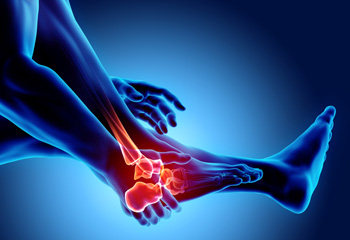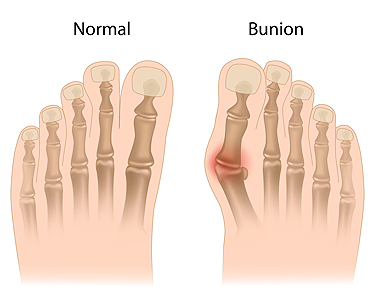Connect With Us
Blog
Items filtered by date: December 2023
Understanding the Causes of Nocturnal Foot Pain

If you have ever experienced the discomfort of foot pain that strikes at night, you are not alone. This phenomenon can be both puzzling and distressing, disrupting precious sleep. There are several potential reasons why your feet can ache during the nighttime hours. One common cause of nighttime foot pain is plantar fasciitis, a condition that involves inflammation of the thick band of tissue that runs along the bottom of your foot. This inflammation can become more pronounced when you rest, leading to pain when you try to sleep. Another possible culprit is neuropathy, a condition characterized by nerve damage. Neuropathy can cause tingling, burning, and sharp pains in the feet, often worsening at night. Diabetes and other underlying medical conditions can contribute to the development of neuropathy. Restless Leg Syndrome, or RLS, is yet another contributor to nocturnal foot pain. Those with RLS experience an irresistible urge to move their legs, often accompanied by uncomfortable sensations like tingling or aching in the feet. This can disrupt sleep and lead to foot discomfort. Ii you are experiencing nighttime foot pain, it is suggested that you consult a podiatrist, who can identify the underlying cause and offer appropriate treatment methods.
Foot Pain
Foot pain can be extremely painful and debilitating. If you have a foot pain, consult with Howard Kimmel, DPM from Buckeye Foot Care. Our doctor will assess your condition and provide you with quality foot and ankle treatment.
Causes
Foot pain is a very broad condition that could be caused by one or more ailments. The most common include:
- Bunions
- Hammertoes
- Plantar Fasciitis
- Bone Spurs
- Corns
- Tarsal Tunnel Syndrome
- Ingrown Toenails
- Arthritis (such as Gout, Rheumatoid, and Osteoarthritis)
- Flat Feet
- Injury (from stress fractures, broken toe, foot, ankle, Achilles tendon ruptures, and sprains)
- And more
Diagnosis
To figure out the cause of foot pain, podiatrists utilize several different methods. This can range from simple visual inspections and sensation tests to X-rays and MRI scans. Prior medical history, family medical history, and any recent physical traumatic events will all be taken into consideration for a proper diagnosis.
Treatment
Treatment depends upon the cause of the foot pain. Whether it is resting, staying off the foot, or having surgery; podiatrists have a number of treatment options available for foot pain.
If you have any questions, please feel free to contact one of our offices located in Brook Park, Beachwood, and Willoughby, OH . We offer the newest diagnostic and treatment technologies for all your foot care needs.
The Underlying Causes of Neuropathy Affecting the Feet

Neuropathy, a condition characterized by nerve damage, can significantly impact the feet, leading to various symptoms that range from tingling sensations to sharp pain. Diabetes stands as a primary contributor to neuropathy, with prolonged elevated blood sugar levels damaging nerves over time. Other systemic conditions such as autoimmune disorders, kidney diseases, and vitamin deficiencies can also instigate neuropathic symptoms in the feet. Moreover, exposure to toxins, certain medications, or infections may provoke neuropathy, affecting the peripheral nerves responsible for transmitting signals between the feet and the central nervous system. Trauma or injury to the nerves, often arising from accidents or surgeries, can induce neuropathic symptoms. Understanding the diverse causes of neuropathy is paramount for an accurate diagnosis and targeted intervention. If you have tingling or numbing sensations in your feet, it is suggested that you schedule an appointment with a podiatrist who can diagnose and treat neuropathy.
Neuropathy
Neuropathy can be a potentially serious condition, especially if it is left undiagnosed. If you have any concerns that you may be experiencing nerve loss in your feet, consult with Howard Kimmel, DPM from Buckeye Foot Care. Our doctor will assess your condition and provide you with quality foot and ankle treatment for neuropathy.
What Is Neuropathy?
Neuropathy is a condition that leads to damage to the nerves in the body. Peripheral neuropathy, or neuropathy that affects your peripheral nervous system, usually occurs in the feet. Neuropathy can be triggered by a number of different causes. Such causes include diabetes, infections, cancers, disorders, and toxic substances.
Symptoms of Neuropathy Include:
- Numbness
- Sensation loss
- Prickling and tingling sensations
- Throbbing, freezing, burning pains
- Muscle weakness
Those with diabetes are at serious risk due to being unable to feel an ulcer on their feet. Diabetics usually also suffer from poor blood circulation. This can lead to the wound not healing, infections occurring, and the limb may have to be amputated.
Treatment
To treat neuropathy in the foot, podiatrists will first diagnose the cause of the neuropathy. Figuring out the underlying cause of the neuropathy will allow the podiatrist to prescribe the best treatment, whether it be caused by diabetes, toxic substance exposure, infection, etc. If the nerve has not died, then it’s possible that sensation may be able to return to the foot.
Pain medication may be issued for pain. Electrical nerve stimulation can be used to stimulate nerves. If the neuropathy is caused from pressure on the nerves, then surgery may be necessary.
If you have any questions, please feel free to contact one of our offices located in Brook Park, Beachwood, and Willoughby, OH . We offer the newest diagnostic and treatment technologies for all your foot care needs.
Bunions and Associated Problems

A bunion, or hallux valgus, is a bony protrusion at the base of the big toe, developing from pressure causing the toe to lean towards the second toe. This misalignment, often resulting from the joint at the toe's base bearing significant weight during activities such as standing and walking, can lead to symptoms like pain, stiffness, redness, and swelling. Additionally, calluses often form due to friction between the big and second toe or on the ball of the foot. Bunions tend to worsen over time if not addressed, possibly causing difficulty in wearing shoes and walking comfortably. While bunions are more common in adults, they can also be present from birth or develop during childhood. The condition can affect one or both feet, posing a persistent challenge to foot comfort and function. If you have an uncomfortable bunion, it is suggested that you schedule an appointment with a podiatrist to discuss treatment options that may increase your comfort.
If you are suffering from bunions, contact Howard Kimmel, DPM of Buckeye Foot Care. Our doctor can provide the care you need to keep you pain-free and on your feet.
What Is a Bunion?
A bunion is formed of swollen tissue or an enlargement of boney growth, usually located at the base joint of the toe that connects to the foot. The swelling occurs due to the bones in the big toe shifting inward, which impacts the other toes of the foot. This causes the area around the base of the big toe to become inflamed and painful.
Why Do Bunions Form?
Genetics – Susceptibility to bunions are often hereditary
Stress on the feet – Poorly fitted and uncomfortable footwear that places stress on feet, such as heels, can worsen existing bunions
How Are Bunions Diagnosed?
Doctors often perform two tests – blood tests and x-rays – when trying to diagnose bunions, especially in the early stages of development. Blood tests help determine if the foot pain is being caused by something else, such as arthritis, while x-rays provide a clear picture of your bone structure to your doctor.
How Are Bunions Treated?
- Refrain from wearing heels or similar shoes that cause discomfort
- Select wider shoes that can provide more comfort and reduce pain
- Anti-inflammatory and pain management drugs
- Orthotics or foot inserts
- Surgery
If you have any questions, please feel free to contact one of our offices located in Brook Park, Beachwood, and Willoughby, OH . We offer the newest diagnostic and treatment technologies for all your foot care needs.
Understanding Metatarsal Fractures

A metatarsal fracture, a common injury affecting the long bones in the foot, occurs when one or more of these slender bones break due to excessive force or trauma. The metatarsals, positioned between the ankle and toes, play an important role in weight-bearing and overall foot function. The fracture can result from various incidents, including falls, direct impact, or sudden twisting motions. High-impact sports or accidents involving heavy objects may contribute to metatarsal fractures. The symptoms typically include pain, swelling, and difficulty bearing weight on the affected foot. Accurate diagnosis through imaging, such as X-rays, is essential for determining the extent of the fracture and guiding appropriate treatment. Understanding the nature of metatarsal fractures is pivotal for prompt medical attention and effective recovery. If you have endured a broken foot, it is suggested that you consult a podiatrist who can diagnose and offer treatment methods that are right for you.
A broken foot requires immediate medical attention and treatment. If you need your feet checked, contact Howard Kimmel, DPM from Buckeye Foot Care. Our doctor can provide the care you need to keep you pain-free and on your feet.
Broken Foot Causes, Symptoms, and Treatment
A broken foot is caused by one of the bones in the foot typically breaking when bended, crushed, or stretched beyond its natural capabilities. Usually the location of the fracture indicates how the break occurred, whether it was through an object, fall, or any other type of injury.
Common Symptoms of Broken Feet:
- Bruising
- Pain
- Redness
- Swelling
- Blue in color
- Numbness
- Cold
- Misshapen
- Cuts
- Deformities
Those that suspect they have a broken foot shoot seek urgent medical attention where a medical professional could diagnose the severity.
Treatment for broken bones varies depending on the cause, severity and location. Some will require the use of splints, casts or crutches while others could even involve surgery to repair the broken bones. Personal care includes the use of ice and keeping the foot stabilized and elevated.
If you have any questions please feel free to contact one of our offices located in Brook Park, Beachwood, and Willoughby, OH . We offer the newest diagnostic and treatment technologies for all your foot and ankle needs.

